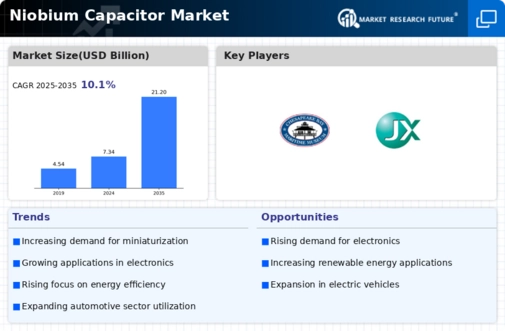Market Share
Niobium Capacitor Market Share Analysis
In the dynamic landscape of the Niobium Capacitor Market, companies employ various market share positioning strategies to carve out a competitive edge and thrive in the industry. One key strategy is differentiation through technological innovation. By investing in research and development, companies can create niobium capacitors with unique features, improved performance, and enhanced efficiency. This technological differentiation allows them to attract customers looking for advanced and cutting-edge solutions, thereby capturing a segment of the market that values innovation.
Another crucial aspect of market share positioning is pricing strategy. Some companies may opt for a cost leadership approach, aiming to offer niobium capacitors at lower prices than competitors while maintaining acceptable quality. This strategy can help attract price-sensitive customers and gain a significant market share based on affordability. On the flip side, premium pricing can be employed by companies focusing on delivering high-quality, premium niobium capacitors with advanced features. This strategy targets customers who prioritize performance over cost and are willing to pay a premium for superior products.
Strategic partnerships and collaborations are also instrumental in market share positioning. Companies may form alliances with other industry players, suppliers, or even research institutions to leverage complementary strengths. These collaborations can lead to shared resources, knowledge exchange, and the development of innovative solutions. By aligning with strategic partners, companies can enhance their capabilities, expand their product portfolios, and secure a more prominent position in the market.
Geographical expansion is a fundamental strategy to increase market share in the Niobium Capacitor Market. Companies may explore untapped markets, both domestically and internationally, to expand their customer base. By identifying regions with growing demand for electronic devices and capacitors, companies can strategically position themselves to capture market share in those areas. This may involve establishing new distribution channels, partnering with local businesses, or setting up manufacturing facilities in key regions.
Customer-centric strategies play a pivotal role in market share positioning. Understanding the needs and preferences of target customers allows companies to tailor their products and services accordingly. Providing excellent customer support, after-sales services, and customization options can create a positive brand perception, fostering customer loyalty and retention. Satisfied customers are more likely to become repeat buyers and advocates for the brand, contributing to increased market share over time.
Mergers and acquisitions represent a strategic move for companies aiming to strengthen their market position. By acquiring or merging with other players in the Niobium Capacitor Market, companies can consolidate resources, streamline operations, and benefit from economies of scale. This strategy not only enhances market share but also positions the company as a key player with a broader product portfolio and increased market influence.
Lastly, a focus on sustainability and environmental responsibility can be a compelling market share positioning strategy. As awareness of environmental issues grows, consumers are increasingly inclined to choose products from companies committed to sustainability. Manufacturers adopting eco-friendly practices in the production of niobium capacitors can appeal to a growing segment of environmentally conscious consumers, positioning themselves as responsible industry leaders.





Leave a Comment